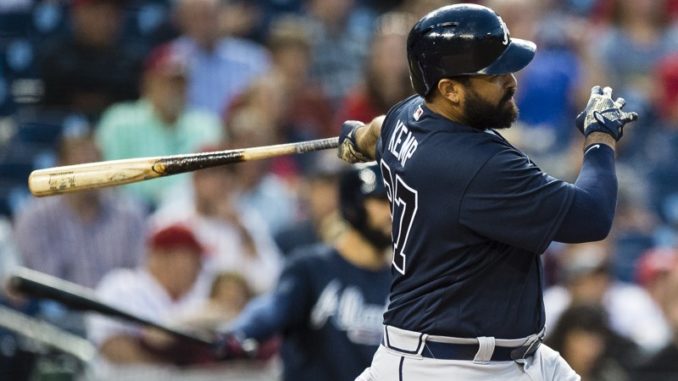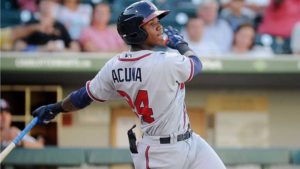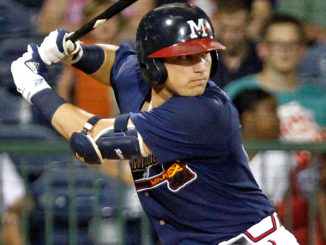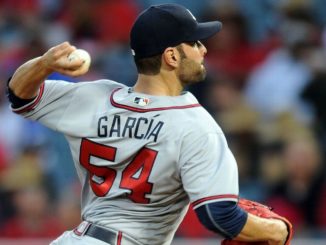
As my colleague Dylan Short recently wrote, 2018 will be pivotal season for the Atlanta Braves. For the first time, a good portion of the roster should be filled with young talent originally brought into the organization through the rebuilding process. The team already seems to have shifted gears from trading off core major league assets to amass minor league talent, as they have not traded a significant major league player with multi-years of team control since the back-to-back trades of Andrelton Simmons and Shelby Miller in December 2015.
One of those key young talents will be outfielder Ronald Acuna, the Braves top prospect and a consensus top prospect in all of baseball. Acuna will only be 20 years old on Opening Day 2018, but there is not much left for him to prove in the minor leagues. Room will need to be made for him, and he will need to start every day. However, the Braves have three veteran outfielders already under contract for 2018 in left fielder Matt Kemp, centerfielder Ender Inciarte, and right fielder Nick Markakis.
While there are pros and cons to trading any of the three, if 2018 is truly to be a year where the Braves make a firm move toward contention, the primary consideration should be which of the three outfielders is most detrimental to the Braves on the field right now. The answer to that question is clearly Matt Kemp.
To put it bluntly, Kemp has no business playing on a National League club. Six years ago, Kemp was arguably the best player in the National League, finishing off a season where he finished second in NL MVP voting (and in my opinion, should have won). Kemp was a powerful and dangerous hitter, a strong baserunner, and a tenacious outfielder that played a credible center field.
Since then however, a horrific series of injuries has robbed Kemp of almost all of his mobility and a good bit of his arm strength.
2012: Two hamstring injuries, knee injury, torn labrum and rotator cuff (from crashing into the outfield wall).
2013: Continuing shoulder and hamstring problems, microfracture of the talus bone in the ankle.
2014: No major injuries, but lack of mobility prompted Dodgers to move Kemp to the corner outfield spots.
2015: Diagnosed by Padres during physical after trade from Dodgers as having chronic arthritic hips. Torn tendon in hand late in season.
2016: Injury free.
2017: Hamstring injuries, first in April, re-injuring in June.
After the Braves acquired Kemp near the trade deadline in 2016, it was hoped that a strong off-season of workouts would allow Kemp to lose weight and become more mobile in the field. To Kemp’s credit, he did arrive in spring training looking much more slim and athletic, but a diving outfield play during an April day game in Pittsburgh in sub-freezing temperatures caused him to re-injure the hamstring. After a DL stint, Kemp was noticeably more tentative in the field, but still hit well. Kemp would aggravate the hamstring again in June on a slide into third base against the Nationals. Kemp would be in-and-out of the line-up over the course of the second half, and the Braves have essentially shut him down to all but pinch hitting appearances since September 20 after yet another set-back.
The nefarious thing about hamstring injuries is that it keeps a player from keeping up his cardio routine, which helps control weight. As such, Kemp has regained the weight he had when he arrived in Atlanta, and likely more, which further hampers his mobility and puts stress on the hamstrings.
It’s difficult watching a talented baseball player betrayed by the fragility of the human body, and Matt Kemp is only the latest example of a player whose prime years have been robbed by injury. Recently turned 33 years old, it seems too young for a player to be resigned to the designated hitter role, but that is just the best role for Kemp as it stands now. With only one injury-free season out of the last five as well as chronic hamstring and hip issues and a rebuilt ankle, Kemp simply does not have the mobility to play a credible outfield on a contending baseball club anymore. Objective measurements bare this out as Statcast rates Kemp as the slowest out of all MLB outfielders with the exception of Toronto’s Jose Bautista. In their Outs Above Average statistic, Kemp rates dead last among all outfielders, with -17 outs below an average outfielder. Think about that… the Braves essentially spotted their opponents collectively almost 6 innings worth of extra outs just by playing Matt Kemp in left field this season. This has little to do with errors, this is mostly just on balls in the air that Kemp couldn’t make a play on.
So those are the basic arguments for moving on from Matt Kemp: he can’t really play National League baseball anymore due the collective toll injuries have taken on his mobility, and there’s a player in the system that is ready to take that spot in the line-up and will improve the club with his better all-round game. Now I want to look at the most common reasons given to keep Kemp around.
1. He provides line-up protection for Freddie Freeman
In a landmark analysis by sabermatrician Tom Tango in 2006, published here in Hardball Times, it was determined that at least statistically line-up protection – the perceived phenomenon that a hitter will get better pitches to hit if a high quality hitter is batting behind him – does not exist. Of course this is baseball and traditions die hard and 10 years after that analysis it was still taken on faith by many fans and players that Freddie Freeman‘s offensive upswing over the last two month of the 2016 season could be attributed to the arrival of Matt Kemp to hit behind him.
My colleague Brent Blackwell looked at this argument last October and pretty much verified that Freeman was not seeing a significant change in quality of pitchers after Kemp’s arrival. With a full season to review, it becomes even clearer that Kemp’s presence hitting behind Freeman does not significantly alter either how pitchers attack Freeman, nor Freeman’s performance.
Freddie Freeman 2017 Metrics: With and Without Matt Kemp (as of 9/26):
| With Kemp | Without Kemp | |
|---|---|---|
| Plate Appearances | 305 | 182 |
| Batting Average | .287 | .350 |
| On-Base % | .387 | .434 |
| Slugging % | .548 | .682 |
| wOBA | .363 | .435 |
| wRC+ | 134 | 188 |
| Fastballs Seen Per Plate Appearance | 1.927 | 1.917 |
2. No one will want to trade for him
Taking away his salary and his previously documented defensive shortcomings, Matt Kemp is still a quality major league batter. It is reasonable to believe that without the strain on the body caused by playing regularly in the outfield that Kemp could maintain his body easier over the course of the season. The one recent season he has had in which he didn’t have a significant injury problem, 2016, Kemp hit .268/.304/.499, good for a 109 wRC+. That would have ranked him 8th among full-time DHs in 2016 and 4th in 2017. That has some value.
Of course, that value is wiped out by the the amount of money still owed to him. Matt Kemp will be paid $43 million over the remaining two years of his current contract. Any team willing to trade for Kemp will demand a large potion of that salary to be paid down by Atlanta.
And Atlanta should do it. As noted above, Kemp has almost no value at any price to a National League team. With the Braves already on the hook for $43 million, nearly any amount of money that can be saved off of that should be considered “found money”. Kemp at $21.5 million a season is a terrible deal. Kemp at $10 million a season is reasonable. Kemp at $7 million a season could be considered a bargain for an American League team. The Braves could also mitigate some of the payroll hit by taking a bad contact back from the other team, or by including a prospect or some other valued asset along with Kemp.
However, the best method would probably be just offering to pay half or more of Kemp’s remaining salary. Roster spots are valuable, and the Braves have enough young talent ready or near-ready to matriculate to the majors without having another low-value, high-priced veteran taking up a spot. Likewise, the Braves should hold their prospects close to the vest; they are still the best and most cost-effective way to increase the talent level of the team, either through performance or through packaging in trades for high-performing veterans.
3. With all of the young players on the roster, the team will need Kemp’s veteran presence
With Freddie Freeman, Tyler Flowers, Kurt Suzuki, Nick Markakis, Jim Johnson, and perhaps R.A. Dickey on the squad, I think they have that covered. Everyone was appreciative of Kemp’s well-written letter at The Players’ Tribune released shortly after his arrival in Atlanta, and by all accounts he has been a fine teammate and veteran leader. However that role is a small part of what a veteran, especially under contract at such a high dollar figure, should be providing his team. If the value on the field is not present, his value in the clubhouse will not be able to mitigate it.
I have no doubt the Braves will have sufficient veteran presence in the clubhouse in 2018, with or without Matt Kemp.
4. Kemp is one of the few sources of power in the line-up
Of all of the reasons to keep Matt Kemp, this is probably the most reasonable and accurate. Other than Freddie Freeman, Kemp is one of the only true power threats in the everyday line-up. The most obvious refutation of that is that Ronald Acuna, the most likely player to take Kemp’s plate appearances, is no slouch in the power department either, having blasted 21 home runs in the minor leagues in 2017. That, of course, isn’t the same as doing it in the major leagues. However, it’s impossible for a player to provide any power if he’s not in the line-up, and based on Kemp’s injury history, it’s more likely that he would continue to miss time than not.

However, even if the Braves don’t make another move to bring in more power to the line-up, there are reasons to believe that the Braves will be OK in the power department in 2018. In addition to Freeman getting more overall plate appearances, the Braves could also pick up more power from all of the other infield positions just through the maturation of Ozzie Albies, Dansby Swanson, Rio Ruiz, and Johan Camargo.
So who would be a likely trade partner with Atlanta on Kemp? Almost every American League team could use a right-handed power bat, with some exceptions like Los Angeles (Albert Pujols), Cleveland (Edwin Encarnacion), Baltimore (Mark Trumbo), and Seattle (Nelson Cruz). Paying down enough salary would even put budget-tight teams like Tampa Bay and Kansas City in play. The deal is out there for a creative general manager.




Kemp for Ellsbury and Kahnle. Granted with Ellsbury the Braves would have an additional $21m to pay over another season compared to Kemp. But, Ellsbury holds more value and allows the Braves to finally trade Markakis.. I added Kahnle because the Yankees will obviously have to add something/someone to the deal to get Atlanta to agree to that additional money.. With the Yankees stacked bullpen they can afford to lose someone like Kahnle who would jump right into the setup position with the Braves and take over the closer role for them in a year or two.. I think that is a solid trade for both teams and Kemp would fill the DH role perfectly. Also, after watching Beltran play RF for 2 and a half years, if, for some reason the Yankees had to put Kemp into RF, I doubt anyone would get upset..